Zijian Chen
MMReID-Bench: Unleashing the Power of MLLMs for Effective and Versatile Person Re-identification
Aug 09, 2025Abstract:Person re-identification (ReID) aims to retrieve the images of an interested person in the gallery images, with wide applications in medical rehabilitation, abnormal behavior detection, and public security. However, traditional person ReID models suffer from uni-modal capability, leading to poor generalization ability in multi-modal data, such as RGB, thermal, infrared, sketch images, textual descriptions, etc. Recently, the emergence of multi-modal large language models (MLLMs) shows a promising avenue for addressing this problem. Despite this potential, existing methods merely regard MLLMs as feature extractors or caption generators, which do not fully unleash their reasoning, instruction-following, and cross-modal understanding capabilities. To bridge this gap, we introduce MMReID-Bench, the first multi-task multi-modal benchmark specifically designed for person ReID. The MMReID-Bench includes 20,710 multi-modal queries and gallery images covering 10 different person ReID tasks. Comprehensive experiments demonstrate the remarkable capabilities of MLLMs in delivering effective and versatile person ReID. Nevertheless, they also have limitations in handling a few modalities, particularly thermal and infrared data. We hope MMReID-Bench can facilitate the community to develop more robust and generalizable multimodal foundation models for person ReID.
Can Large Models Fool the Eye? A New Turing Test for Biological Animation
Aug 08, 2025Abstract:Evaluating the abilities of large models and manifesting their gaps are challenging. Current benchmarks adopt either ground-truth-based score-form evaluation on static datasets or indistinct textual chatbot-style human preferences collection, which may not provide users with immediate, intuitive, and perceptible feedback on performance differences. In this paper, we introduce BioMotion Arena, a novel framework for evaluating large language models (LLMs) and multimodal large language models (MLLMs) via visual animation. Our methodology draws inspiration from the inherent visual perception of motion patterns characteristic of living organisms that utilizes point-light source imaging to amplify the performance discrepancies between models. Specifically, we employ a pairwise comparison evaluation and collect more than 45k votes for 53 mainstream LLMs and MLLMs on 90 biological motion variants. Data analyses show that the crowd-sourced human votes are in good agreement with those of expert raters, demonstrating the superiority of our BioMotion Arena in offering discriminative feedback. We also find that over 90\% of evaluated models, including the cutting-edge open-source InternVL3 and proprietary Claude-4 series, fail to produce fundamental humanoid point-light groups, much less smooth and biologically plausible motions. This enables BioMotion Arena to serve as a challenging benchmark for performance visualization and a flexible evaluation framework without restrictions on ground-truth.
The Ever-Evolving Science Exam
Jul 22, 2025Abstract:As foundation models grow rapidly in capability and deployment, evaluating their scientific understanding becomes increasingly critical. Existing science benchmarks have made progress towards broad **Range**, wide **Reach**, and high **Rigor**, yet they often face two major challenges: **data leakage risks** that compromise benchmarking validity, and **evaluation inefficiency** due to large-scale testing. To address these issues, we introduce the **Ever-Evolving Science Exam (EESE)**, a dynamic benchmark designed to reliably assess scientific capabilities in foundation models. Our approach consists of two components: 1) a non-public **EESE-Pool** with over 100K expertly constructed science instances (question-answer pairs) across 5 disciplines and 500+ subfields, built through a multi-stage pipeline ensuring **Range**, **Reach**, and **Rigor**, 2) a periodically updated 500-instance subset **EESE**, sampled and validated to enable leakage-resilient, low-overhead evaluations. Experiments on 32 open- and closed-source models demonstrate that EESE effectively differentiates the strengths and weaknesses of models in scientific fields and cognitive dimensions. Overall, EESE provides a robust, scalable, and forward-compatible solution for science benchmark design, offering a realistic measure of how well foundation models handle science questions. The project page is at: https://github.com/aiben-ch/EESE.
RankLLM: A Python Package for Reranking with LLMs
May 25, 2025Abstract:The adoption of large language models (LLMs) as rerankers in multi-stage retrieval systems has gained significant traction in academia and industry. These models refine a candidate list of retrieved documents, often through carefully designed prompts, and are typically used in applications built on retrieval-augmented generation (RAG). This paper introduces RankLLM, an open-source Python package for reranking that is modular, highly configurable, and supports both proprietary and open-source LLMs in customized reranking workflows. To improve usability, RankLLM features optional integration with Pyserini for retrieval and provides integrated evaluation for multi-stage pipelines. Additionally, RankLLM includes a module for detailed analysis of input prompts and LLM responses, addressing reliability concerns with LLM APIs and non-deterministic behavior in Mixture-of-Experts (MoE) models. This paper presents the architecture of RankLLM, along with a detailed step-by-step guide and sample code. We reproduce results from RankGPT, LRL, RankVicuna, RankZephyr, and other recent models. RankLLM integrates with common inference frameworks and a wide range of LLMs. This compatibility allows for quick reproduction of reported results, helping to speed up both research and real-world applications. The complete repository is available at rankllm.ai, and the package can be installed via PyPI.
LOVE: Benchmarking and Evaluating Text-to-Video Generation and Video-to-Text Interpretation
May 17, 2025Abstract:Recent advancements in large multimodal models (LMMs) have driven substantial progress in both text-to-video (T2V) generation and video-to-text (V2T) interpretation tasks. However, current AI-generated videos (AIGVs) still exhibit limitations in terms of perceptual quality and text-video alignment. Therefore, a reliable and scalable automatic model for AIGV evaluation is desirable, which heavily relies on the scale and quality of human annotations. To this end, we present AIGVE-60K, a comprehensive dataset and benchmark for AI-Generated Video Evaluation, which features (i) comprehensive tasks, encompassing 3,050 extensive prompts across 20 fine-grained task dimensions, (ii) the largest human annotations, including 120K mean-opinion scores (MOSs) and 60K question-answering (QA) pairs annotated on 58,500 videos generated from 30 T2V models, and (iii) bidirectional benchmarking and evaluating for both T2V generation and V2T interpretation capabilities. Based on AIGVE-60K, we propose LOVE, a LMM-based metric for AIGV Evaluation from multiple dimensions including perceptual preference, text-video correspondence, and task-specific accuracy in terms of both instance level and model level. Comprehensive experiments demonstrate that LOVE not only achieves state-of-the-art performance on the AIGVE-60K dataset, but also generalizes effectively to a wide range of other AIGV evaluation benchmarks. These findings highlight the significance of the AIGVE-60K dataset. Database and codes are anonymously available at https://github.com/IntMeGroup/LOVE.
What Is Next for LLMs? Next-Generation AI Computing Hardware Using Photonic Chips
May 09, 2025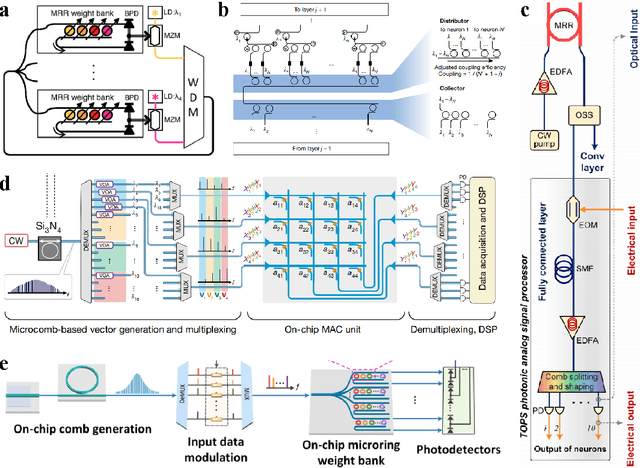
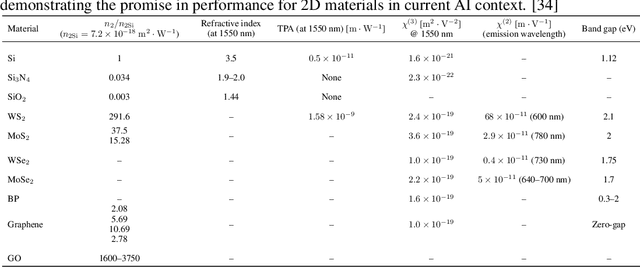
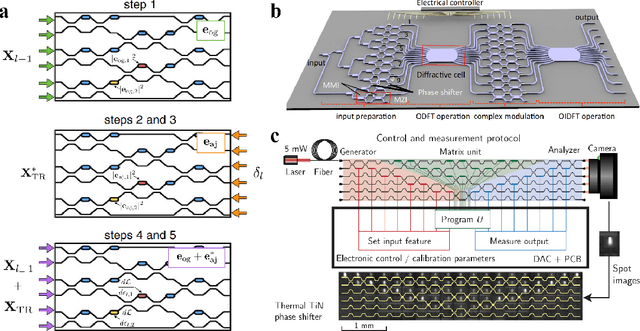

Abstract:Large language models (LLMs) are rapidly pushing the limits of contemporary computing hardware. For example, training GPT-3 has been estimated to consume around 1300 MWh of electricity, and projections suggest future models may require city-scale (gigawatt) power budgets. These demands motivate exploration of computing paradigms beyond conventional von Neumann architectures. This review surveys emerging photonic hardware optimized for next-generation generative AI computing. We discuss integrated photonic neural network architectures (e.g., Mach-Zehnder interferometer meshes, lasers, wavelength-multiplexed microring resonators) that perform ultrafast matrix operations. We also examine promising alternative neuromorphic devices, including spiking neural network circuits and hybrid spintronic-photonic synapses, which combine memory and processing. The integration of two-dimensional materials (graphene, TMDCs) into silicon photonic platforms is reviewed for tunable modulators and on-chip synaptic elements. Transformer-based LLM architectures (self-attention and feed-forward layers) are analyzed in this context, identifying strategies and challenges for mapping dynamic matrix multiplications onto these novel hardware substrates. We then dissect the mechanisms of mainstream LLMs, such as ChatGPT, DeepSeek, and LLaMA, highlighting their architectural similarities and differences. We synthesize state-of-the-art components, algorithms, and integration methods, highlighting key advances and open issues in scaling such systems to mega-sized LLM models. We find that photonic computing systems could potentially surpass electronic processors by orders of magnitude in throughput and energy efficiency, but require breakthroughs in memory, especially for long-context windows and long token sequences, and in storage of ultra-large datasets.
OBIFormer: A Fast Attentive Denoising Framework for Oracle Bone Inscriptions
Apr 18, 2025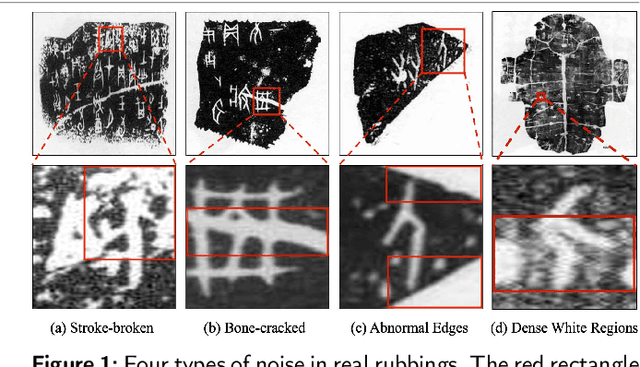
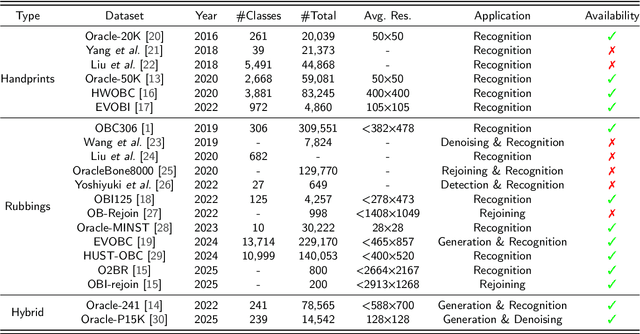
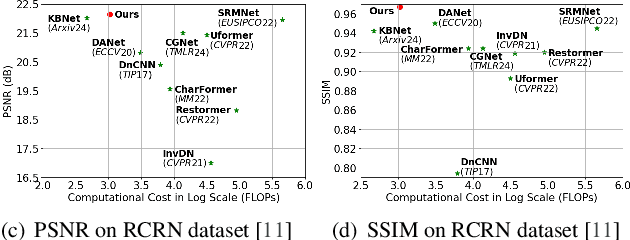
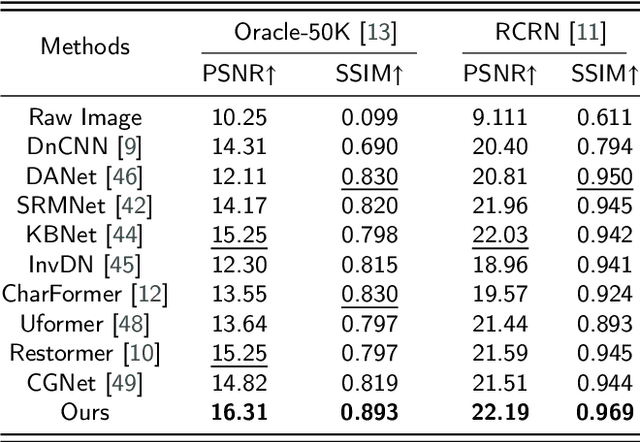
Abstract:Oracle bone inscriptions (OBIs) are the earliest known form of Chinese characters and serve as a valuable resource for research in anthropology and archaeology. However, most excavated fragments are severely degraded due to thousands of years of natural weathering, corrosion, and man-made destruction, making automatic OBI recognition extremely challenging. Previous methods either focus on pixel-level information or utilize vanilla transformers for glyph-based OBI denoising, which leads to tremendous computational overhead. Therefore, this paper proposes a fast attentive denoising framework for oracle bone inscriptions, i.e., OBIFormer. It leverages channel-wise self-attention, glyph extraction, and selective kernel feature fusion to reconstruct denoised images precisely while being computationally efficient. Our OBIFormer achieves state-of-the-art denoising performance for PSNR and SSIM metrics on synthetic and original OBI datasets. Furthermore, comprehensive experiments on a real oracle dataset demonstrate the great potential of our OBIFormer in assisting automatic OBI recognition. The code will be made available at https://github.com/LJHolyGround/OBIFormer.
Mitigating Long-tail Distribution in Oracle Bone Inscriptions: Dataset, Model, and Benchmark
Apr 16, 2025Abstract:The oracle bone inscription (OBI) recognition plays a significant role in understanding the history and culture of ancient China. However, the existing OBI datasets suffer from a long-tail distribution problem, leading to biased performance of OBI recognition models across majority and minority classes. With recent advancements in generative models, OBI synthesis-based data augmentation has become a promising avenue to expand the sample size of minority classes. Unfortunately, current OBI datasets lack large-scale structure-aligned image pairs for generative model training. To address these problems, we first present the Oracle-P15K, a structure-aligned OBI dataset for OBI generation and denoising, consisting of 14,542 images infused with domain knowledge from OBI experts. Second, we propose a diffusion model-based pseudo OBI generator, called OBIDiff, to achieve realistic and controllable OBI generation. Given a clean glyph image and a target rubbing-style image, it can effectively transfer the noise style of the original rubbing to the glyph image. Extensive experiments on OBI downstream tasks and user preference studies show the effectiveness of the proposed Oracle-P15K dataset and demonstrate that OBIDiff can accurately preserve inherent glyph structures while transferring authentic rubbing styles effectively.
PuzzleBench: A Fully Dynamic Evaluation Framework for Large Multimodal Models on Puzzle Solving
Apr 15, 2025Abstract:Large Multimodal Models (LMMs) have demonstrated impressive capabilities across a wide range of multimodal tasks, achieving ever-increasing performance on various evaluation benchmarks. However, existing benchmarks are typically static and often overlap with pre-training datasets, leading to fixed complexity constraints and substantial data contamination issues. Meanwhile, manually annotated datasets are labor-intensive, time-consuming, and subject to human bias and inconsistency, leading to reliability and reproducibility issues. To address these problems, we propose a fully dynamic multimodal evaluation framework, named Open-ended Visual Puzzle Generation (OVPG), which aims to generate fresh, diverse, and verifiable evaluation data automatically in puzzle-solving tasks. Specifically, the OVPG pipeline consists of a raw material sampling module, a visual content generation module, and a puzzle rule design module, which ensures that each evaluation instance is primitive, highly randomized, and uniquely solvable, enabling continual adaptation to the evolving capabilities of LMMs. Built upon OVPG, we construct PuzzleBench, a dynamic and scalable benchmark comprising 11,840 VQA samples. It features six carefully designed puzzle tasks targeting three core LMM competencies, visual recognition, logical reasoning, and context understanding. PuzzleBench differs from static benchmarks that quickly become outdated. It enables ongoing dataset refreshing through OVPG and a rich set of open-ended puzzle designs, allowing seamless adaptation to the evolving capabilities of LMMs.
Zero-Shot ATC Coding with Large Language Models for Clinical Assessments
Dec 10, 2024



Abstract:Manual assignment of Anatomical Therapeutic Chemical (ATC) codes to prescription records is a significant bottleneck in healthcare research and operations at Ontario Health and InterRAI Canada, requiring extensive expert time and effort. To automate this process while maintaining data privacy, we develop a practical approach using locally deployable large language models (LLMs). Inspired by recent advances in automatic International Classification of Diseases (ICD) coding, our method frames ATC coding as a hierarchical information extraction task, guiding LLMs through the ATC ontology level by level. We evaluate our approach using GPT-4o as an accuracy ceiling and focus development on open-source Llama models suitable for privacy-sensitive deployment. Testing across Health Canada drug product data, the RABBITS benchmark, and real clinical notes from Ontario Health, our method achieves 78% exact match accuracy with GPT-4o and 60% with Llama 3.1 70B. We investigate knowledge grounding through drug definitions, finding modest improvements in accuracy. Further, we show that fine-tuned Llama 3.1 8B matches zero-shot Llama 3.1 70B accuracy, suggesting that effective ATC coding is feasible with smaller models. Our results demonstrate the feasibility of automatic ATC coding in privacy-sensitive healthcare environments, providing a foundation for future deployments.
 Add to Chrome
Add to Chrome Add to Firefox
Add to Firefox Add to Edge
Add to Edge